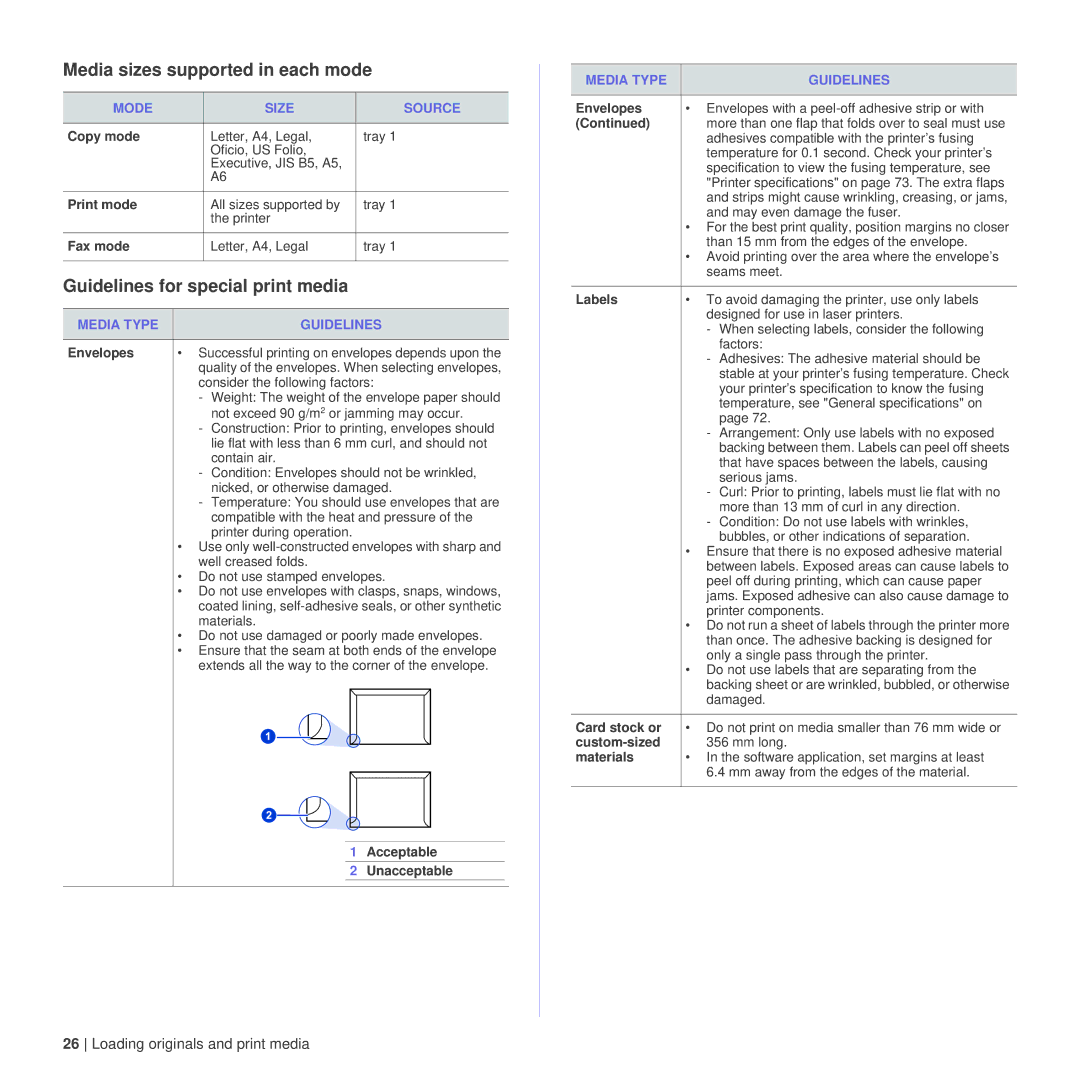
Media sizes supported in each mode
MODE | SIZE | SOURCE |
|
|
|
Copy mode | Letter, A4, Legal, | tray 1 |
| Oficio, US Folio, |
|
| Executive, JIS B5, A5, |
|
| A6 |
|
|
|
|
Print mode | All sizes supported by | tray 1 |
| the printer |
|
|
|
|
Fax mode | Letter, A4, Legal | tray 1 |
|
|
|
Guidelines for special print media
MEDIA TYPE |
| GUIDELINES | ||||||
|
|
|
|
|
|
|
| |
Envelopes | • Successful printing on envelopes depends upon the | |||||||
| quality of the envelopes. When selecting envelopes, | |||||||
| consider the following factors: | |||||||
| - | Weight: The weight of the envelope paper should | ||||||
|
| not exceed 90 g/m2 or jamming may occur. | ||||||
| - | Construction: Prior to printing, envelopes should | ||||||
|
| lie flat with less than 6 mm curl, and should not | ||||||
|
| contain air. | ||||||
| - | Condition: Envelopes should not be wrinkled, | ||||||
|
| nicked, or otherwise damaged. | ||||||
| - | Temperature: You should use envelopes that are | ||||||
|
| compatible with the heat and pressure of the | ||||||
|
| printer during operation. | ||||||
| • Use only | |||||||
| well creased folds. | |||||||
| • Do not use stamped envelopes. | |||||||
| • Do not use envelopes with clasps, snaps, windows, | |||||||
| coated lining, | |||||||
| materials. | |||||||
| • Do not use damaged or poorly made envelopes. | |||||||
| • Ensure that the seam at both ends of the envelope | |||||||
| extends all the way to the corner of the envelope. | |||||||
|
|
|
|
|
|
|
|
|
|
|
|
|
|
|
|
|
|
|
|
|
|
|
|
|
|
|
|
|
|
|
|
|
|
|
|
|
|
|
|
|
|
|
|
|
|
|
|
|
|
|
|
|
|
|
|
|
|
|
|
|
|
|
|
|
|
|
|
|
|
|
|
|
|
|
|
|
|
|
|
|
1 | Acceptable |
2 | Unacceptable |
MEDIA TYPE |
| GUIDELINES |
|
| |
Envelopes | • Envelopes with a | |
(Continued) | more than one flap that folds over to seal must use | |
| adhesives compatible with the printer’s fusing | |
| temperature for 0.1 second. Check your printer’s | |
| specification to view the fusing temperature, see | |
| "Printer specifications" on page 73. The extra flaps | |
| and strips might cause wrinkling, creasing, or jams, | |
| and may even damage the fuser. | |
| • For the best print quality, position margins no closer | |
| than 15 mm from the edges of the envelope. | |
| • Avoid printing over the area where the envelope’s | |
| seams meet. | |
|
| |
Labels | • To avoid damaging the printer, use only labels | |
| designed for use in laser printers. | |
| - | When selecting labels, consider the following |
|
| factors: |
| - | Adhesives: The adhesive material should be |
|
| stable at your printer’s fusing temperature. Check |
|
| your printer’s specification to know the fusing |
|
| temperature, see "General specifications" on |
|
| page 72. |
| - | Arrangement: Only use labels with no exposed |
|
| backing between them. Labels can peel off sheets |
|
| that have spaces between the labels, causing |
|
| serious jams. |
| - | Curl: Prior to printing, labels must lie flat with no |
|
| more than 13 mm of curl in any direction. |
| - | Condition: Do not use labels with wrinkles, |
|
| bubbles, or other indications of separation. |
| • Ensure that there is no exposed adhesive material | |
| between labels. Exposed areas can cause labels to | |
| peel off during printing, which can cause paper | |
| jams. Exposed adhesive can also cause damage to | |
| printer components. | |
| • Do not run a sheet of labels through the printer more | |
| than once. The adhesive backing is designed for | |
| only a single pass through the printer. | |
| • Do not use labels that are separating from the | |
| backing sheet or are wrinkled, bubbled, or otherwise | |
| damaged. | |
|
| |
Card stock or | • Do not print on media smaller than 76 mm wide or | |
356 mm long. | ||
materials | • In the software application, set margins at least | |
| 6.4 mm away from the edges of the material. | |
|
|
|
